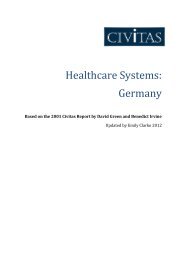The German Sparkassen: A Commentary and Case study - Civitas
The German Sparkassen: A Commentary and Case study - Civitas
The German Sparkassen: A Commentary and Case study - Civitas
You also want an ePaper? Increase the reach of your titles
YUMPU automatically turns print PDFs into web optimized ePapers that Google loves.
small <strong>and</strong> medium sized companies. <strong>The</strong> local Savings Bank is regarded as the ‘house bank’ <strong>and</strong><br />
ensures a long-term <strong>and</strong> secure relationship with each of their commercial customers. <strong>The</strong> Savings<br />
Bank Group in total provides currently 42.7 per cent of all finance to <strong>German</strong> businesses.<br />
<strong>The</strong> role that the <strong>German</strong> government exercised during this critical period has also to be recognised.<br />
Very quickly, once the potential depth of the recession became apparent, legislation 4 was<br />
introduced that provided additional funds to companies that were obliged to put employees on<br />
short-time working. In summary, the employer was able to declare short-time working <strong>and</strong> continued<br />
to pay the employee for the time worked; the State paid for the time not worked at a rate<br />
of 60 per cent of the net income. <strong>The</strong> effect was that an employee on short-time working received<br />
over 80 per cent of the net income that would have been earned in full-time work <strong>and</strong>, crucially,<br />
employment was preserved. It is estimated that over half a million jobs were protected at a cost<br />
to the state of around €5 billion each year. At the peak, some 1.1 million people were being supported<br />
by the scheme.<br />
Since the recession <strong>German</strong> industry has recovered at a remarkable rate, supported by the retention<br />
of skilled <strong>and</strong> committed employees <strong>and</strong> the additional investment in research <strong>and</strong> development<br />
made during the period of low dem<strong>and</strong>.<br />
Production Index for <strong>German</strong> Manufacturing Industry (2005 = 100)<br />
Production Index for <strong>German</strong> Manufacturing Industry (2005 = 100)<br />
125<br />
120<br />
115<br />
110<br />
105<br />
100<br />
95<br />
90<br />
Part I: A commentary<br />
85<br />
80<br />
Jan<br />
Feb<br />
Mar<br />
Apr<br />
May<br />
Jun<br />
Jul<br />
Aug<br />
Sep<br />
Oct<br />
Nov<br />
Dec<br />
Jan<br />
Feb<br />
Mar<br />
Apr<br />
May<br />
Jun<br />
Jul<br />
Aug<br />
Sep<br />
Oct<br />
Nov<br />
Dec<br />
Jan<br />
Feb<br />
Mar<br />
Apr<br />
May<br />
Jun<br />
Jul<br />
Aug<br />
Sep<br />
Oct<br />
Nov<br />
Dec<br />
Jan<br />
Feb<br />
Mar<br />
Apr<br />
May<br />
Jun<br />
Jul<br />
Aug<br />
Sep<br />
Oct<br />
Nov<br />
Dec<br />
Jan<br />
Feb<br />
Mar<br />
Apr<br />
May<br />
Jun<br />
2008<br />
2009<br />
2010<br />
Source: Statistisches Bundesamt <strong>and</strong> SIMAS<br />
2011<br />
2012<br />
In the period from January to April 2012, loans to business provided by the Savings Bank Group<br />
increased by a further €5.6 billion, reaching a total of €332.1 billion, corresponding to an increase<br />
of 1.7 per cent. This has allowed industry to maintain investment in more efficient plant <strong>and</strong> machinery,<br />
<strong>and</strong> in increasing capacity.<br />
<strong>The</strong> current situation has been described as one where most manufacturing companies are fundamentally<br />
strong. As the new president of the DSGV, Georg Fahrenschon, said in June 2012: ‘Der<br />
5




